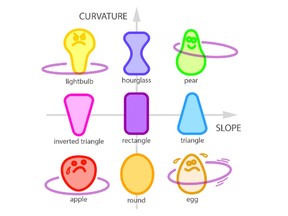Article content
It turns out that hula hooping comes naturally to certain people and no matter how hard others may try, they still won’t be able to keep the hoop elevated for long. A new study published by researchers at New York University is explaining why.
The hula hoop skyrocketed in popularity in the 1950s, first in Australia, and then in the United States, according to Timeless Toys by Tim Walsh. Decades later, it has remained on store shelves as a simple yet fun and challenging option for children and adults alike. Researchers looked at the hoop inquisitively, seeking to answer the questions: “What keeps a hula hoop up against gravity?” And: “Are some body types better for hula hooping than others?”
Researchers of the study, published in the Jan. 7 issue of Proceedings of the National Academy of Sciences, conducted experiments using different shapes and motions on robotic hula hoopers. They mimicked human bodies by using 3D-printed bodies that were one-tenth the size.
“These shapes were driven to gyrate by a motor, replicating the motions we take when hula hooping. Hoops approximately 6 inches in diameter were launched on these bodies, with high-speed video capturing the movements,” per a news release about the study.
Video shared by the researchers illustrate how the experiment worked, showing a robot with an hourglass form keeping the hoop in place.
Article content
“We were specifically interested in what kinds of body motions and shapes could successfully hold the hoop up and what physical requirements and restrictions are involved,” said associate professor at NYU’s Courant Institute of Mathematical Sciences and the senior author of the paper Leif Ristroph.
And, according to science, hips don’t lie.
The reason some people cannot hoop for long periods of time has nothing to do with technique or form. It has to do with their body shape.
“In all cases, good twirling motions of the hoop around the body could be set up without any special effort,” Ristroph said. But, when it came to keeping the hoop elevated, a certain body type was required, the study found.
Through their experiments, researchers wrote in the study that they discovered that “keeping a hoop at a level requires a sloped surface with ‘hips’ and a curvy ‘waist.’”

The best body shape for hula hooping is a pear-shaped one, which provides perfect amount of the slope and curvature, whereas a person with an apple-shaped body would have trouble keeping the hoop off of the ground.
Article content
Rectangle, triangle and hourglass body types would have less difficulty keeping the hoop in motion compared to lightbulb, inverted triangle and round shapes.
“People come in many different body types — some who have these slope and curvature traits in their hips and waist and some who don’t,” said Ristroph. “Our results might explain why some people are natural hoopers and others seem to have to work extra hard.”
Another goal of the researchers’ findings, they wrote in the study, was to “inspire and inform robotic applications for transforming motions, extracting energy from vibrations, and controlling and manipulating objects without gripping.”
Recommended from Editorial
-

Want to know if you’re aging in a healthy way? Try standing on one leg
-

People at these two jobs had lowest risk of Alzheimer’s as cause of death, study finds
Share this article in your social network
#hula #hoop #technique













Leave a Reply